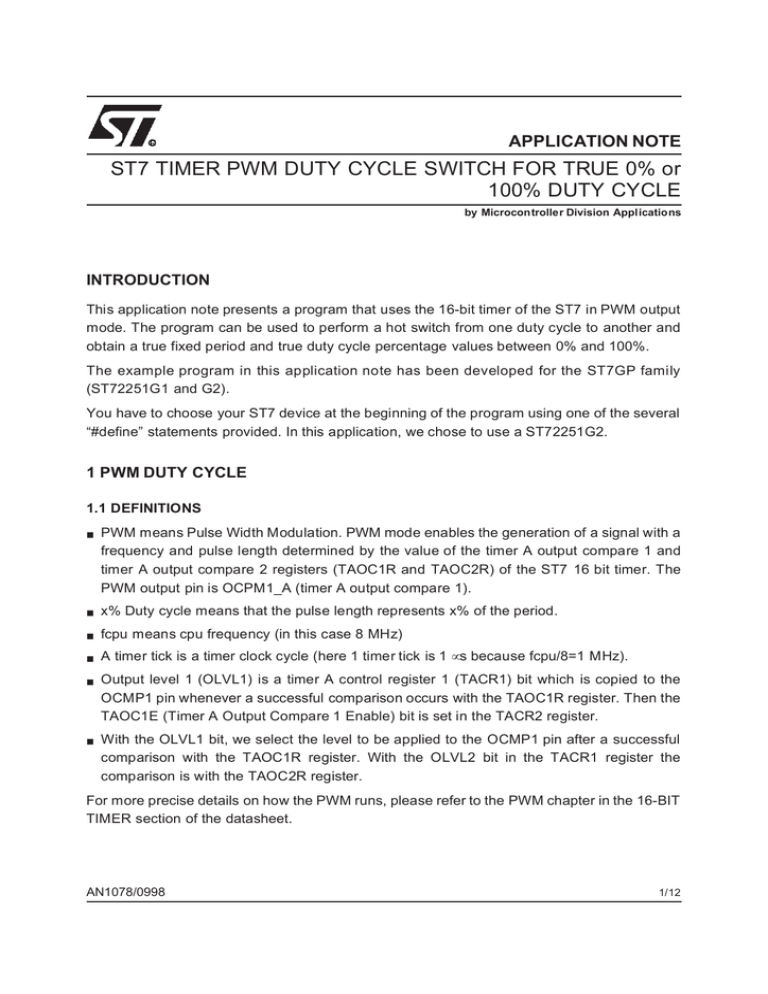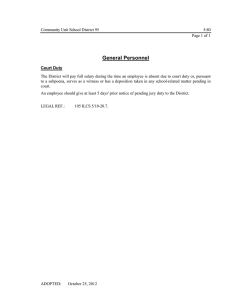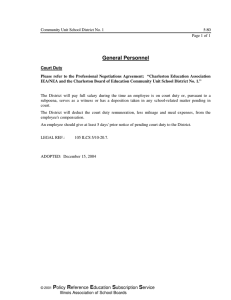
APPLICATION NOTE
ST7 TIMER PWM DUTY CYCLE SWITCH FOR TRUE 0% or
100% DUTY CYCLE
by Microcontroller Division Applications
INTRODUCTION
This application note presents a program that uses the 16-bit timer of the ST7 in PWM output
mode. The program can be used to perform a hot switch from one duty cycle to another and
obtain a true fixed period and true duty cycle percentage values between 0% and 100%.
The example program in this application note has been developed for the ST7GP family
(ST72251G1 and G2).
You have to choose your ST7 device at the beginning of the program using one of the several
“#define” statements provided. In this application, we chose to use a ST72251G2.
1 PWM DUTY CYCLE
1.1 DEFINITIONS
■
PWM means Pulse Width Modulation. PWM mode enables the generation of a signal with a
frequency and pulse length determined by the value of the timer A output compare 1 and
timer A output compare 2 registers (TAOC1R and TAOC2R) of the ST7 16 bit timer. The
PWM output pin is OCPM1_A (timer A output compare 1).
■
x% Duty cycle means that the pulse length represents x% of the period.
■
fcpu means cpu frequency (in this case 8 MHz)
■
A timer tick is a timer clock cycle (here 1 timer tick is 1 µs because fcpu/8=1 MHz).
■
■
Output level 1 (OLVL1) is a timer A control register 1 (TACR1) bit which is copied to the
OCMP1 pin whenever a successful comparison occurs with the TAOC1R register. Then the
TAOC1E (Timer A Output Compare 1 Enable) bit is set in the TACR2 register.
With the OLVL1 bit, we select the level to be applied to the OCMP1 pin after a successful
comparison with the TAOC1R register. With the OLVL2 bit in the TACR1 register the
comparison is with the TAOC2R register.
For more precise details on how the PWM runs, please refer to the PWM chapter in the 16-BIT
TIMER section of the datasheet.
AN1078/0998
1/12
1
ST7 TIMER PWM DUTY CYCLE SWITCH FOR TRUE 0% or 100% DUTY CYCLE
1.2 16 BIT TIMER OPERATION IN PWM MODE
The PWM mode uses the complete Timer A Output Compare 1 function plus the TAOC2R
register. An Output Compare 2 event causes the counter to be initialized to FFFCh which is
the counter reset value. So after each period, the counter is reset to FFFCh. As shown in
Figure 1 the pulse length and the period that you can see are 5 timer ticks longer than the
values you have loaded in the TAOC1R and in TAOC2R registers.
Figure 1. General frame without correction of the 5 time tick shift
COUNTER
OCMP1_A
34DD FFFC FFFD FFFE FFFF 0000
0001
2100
OLVL2
OLVL1
2101
OLVL1
compare1
compare2
pulse length =OC1R+5
Note: TAOC1R=2100h, TAOC2R=34DDh, OLVL1=0, OLVL2= 1
The minimum value available for the pulse length is programmed when you load the counter
reset value in TAOC1R (FFFCh). Instead of having 0% duty cycle, the PWM mode feature
produces a 1 timer tick pulse as shown in Figure 2.
Figure 2. 0% duty cycle minimum value with OC1R=FFFCh=Counter Reset Value
COUNTER
34DD FFFC FFFD FFFE
OLVL1
OLVL1
OCMP1_A
2ED0 2ED1 2ED2
34DD FFFC
OLVL1
OLVL1
OLVL2
compare2 compare1
OLVL2
compare2
compare1
Note: TAOC1R=FFFCh, TAOC2R=34DDh, OLVL1=0, OLVL2= 1
When you set the pulse length equal to the period in order to have a 100% duty cycle, you
have a pulse of one CPU tick as shown in Figure 3. This could be useful for performing an external synchronization. However if you want a really 100% duty cycle you can use the TRUE
routine described below.
2/12
ST7 TIMER PWM DUTY CYCLE SWITCH FOR TRUE 0% or 100% DUTY CYCLE
Figure 3. 100% duty cycle with TAOC1R=TAOC2R=Period
COUNTER
OCMP1_A
34DC 34DD FFFC FFFD
OLVL2
OLVL2
2ED0 2ED1 2ED2
34DD FFFC
OLVL2
1 cpu tick
OLVL1
OLVL2
1 cpu tick
OLVL1
Note: TAOC1R=34DDh, TAOC2R=34DDh, OLVL1=0, OLVL2= 1
1.3 PROGRAM OBJECTIVES
The three following objectives are achieved by our TRUE routine. The routine is called in the
“ext0_rt” interrupt routine which changes the duty cycle value. The “init_prog“ routine loads the
desired period value minus five in the TAOC2R register to obtain the correct timer tick value
for the period.
1.3.1 Decrement the pulse length by 5 timer ticks
To obtain the correct timer tick value for the pulse length, we subtract 5 timer ticks before
loading them in the TAOC1R register.
1.3.2 Obtain a true 0% duty cycle
On the following program the “true” routine rectifies the 1 timer tick glitch by resetting the
OLVL2 bit (OLVL2=OLVL1=0) of the TACR1 register in order to have a true 0% duty cycle.
This is done by comparing the pulse length value with 0000h.
1.3.3 Obtain a true 100% duty cycle
On the following program the “true” routine produces a true 100% duty cycle by setting OLVL1
bit (OLVL1=OLVL2=1) of the TACR1 register in order to suppress the pulse of one CPU tick.
This is done by comparing the pulse length value with the period length (constant defined at
the beginning of the program).
Note: You can use the program to switch to different duty cycles by looping through the following series of constants using the “ext0_rt” interrupt routine: 100%, 75%, 50%, 25%, 0%,
25%...
The switch is caused by a falling edge on PA0. PA0 is configured as an input with pull up and
interrupt, a low level applied on this pin causes an external interrupt.
By default when you run the program you have a 100% duty cycle with the one timer tick pulse
as explained above.
3/12
ST7 TIMER PWM DUTY CYCLE SWITCH FOR TRUE 0% or 100% DUTY CYCLE
2 FLOWCHARTS
Figure 4. Main routine (for ST72251G2)
TAOCR1=TAOCR2=desired period-5
(no correction so 1 cpu tick pulse)
Falling edge on PA0
state=1001 0000
so 100% period (true 100%)
Falling edge on PA0
state=1000 1000
75% period
Falling edge on PA0
state=1000 0100
50% period
Falling edge on PA0
state=1000 0010
25% period
Falling edge on PA0
state=1000 0001
0% period
Falling edge on PA0
state=0000 0010
25% period
Falling edge on PA0
state=0000 0100
50% period
Falling edge on PA0
state=0000 1000
75% period
The falling edges on PA0 allow you to switch from one duty cycle value to another by executing the “ext0_rt” interrupt routine.
4/12
ST7 TIMER PWM DUTY CYCLE SWITCH FOR TRUE 0% or 100% DUTY CYCLE
Figure 5. The “ext0_rt” interrupt routine (here for a ST72251G2)
Falling edge on
PA0
Tests of ”state” value
Call the TRUE routine
N
Y
up/down=1?
N
Y
N
0% ?
SLA state
Clear ”state”
BSET up/down
Load next duty
cycle value (75%)
in ”state”
IRET
IRET
SRA state
IRET
Y
100% ?
To use the duty cycle values in increasing or decreasing order, we use the up/down bit of the
“state” 8-bit variable. The up/down bit is the seventh bit of “state”. The others are used to code
the duty cycle value. Look at the following code meaning with x =up/down:
■
100% duty cycle -> x001 0000
■
75% duty cycle -> x000 1000
■
50% duty cycle -> x000 0100
■
25% duty cycle -> x000 0010
■
0% duty cycle -> x000 0001
5/12
ST7 TIMER PWM DUTY CYCLE SWITCH FOR TRUE 0% or 100% DUTY CYCLE
Figure 6. The “true” routine flowchart
Call the TRUE routine
N
Y
0% ?
N
Y
100% ?
OLVL2=0
LOAD of TAOC1R and
subtract 5 timer ticks
OLVL1=1
RET
RET
RET
This routine performs the 5 timer tick shift, and generates a true 0% or 100% duty cycle using
the OLVL1 and OLVL2 bits.
6/12
ST7 TIMER PWM DUTY CYCLE SWITCH FOR TRUE 0% or 100% DUTY CYCLE
3 SOFTWARE
The assembly code given below is guidance only. The complete software with all the files can
be found in the software library.
st7/
; the first line is reserved
; for specifying the instruction set
; of the target processor
;*************** *********************************************************
; TITLE:
PWM.ASM
; AUTHOR:
PPG Microcontroller Application Team
; DESCRIPTION:
Demonstration Program
;
for the Timer peripheral used in PWM configuration.
;
This program illustrates the timer’s behavi our when it is
;
configured in PWM mode.
;
A PWM signal will be generated on OCMP1_A pin. The length
;
of the pulse is located in the OCR1 register while the
;
signal’s period is in the OCR2 register.
;
We begin by a normal 100% Duty Cycle which has a one cpu tick
;
pulse by default.
;
At each falling edge on PA0,(cf ST72 trainin g board
;
button) you change the Duty Cycle by loopin g through this
;
sequence of values:true 100% 75% 50% 25% 0% 25% 50% 75%
;
\_______________________|
;
The interrupt produced by the ICF1 bit at the end of each
;
period is used to toggle PB7.
;*************** *********************************************************
TITLE ”PWM.ASM” ; this title will appear on each page of the listing file
MOTOROLA
; this directive forces the Motorola
; format for the assembly (default)
#INCLUDE ”st72251.inc”; include st72251 registers and memory
;*************** ********************************************************
;
Variables, constants defined and referenced locally
;
You can define your own values for a local reference here
;*************** ********************************************************
#define
up/down 7
;To use sequence in increa sing or decrasing order
#define
OLVL1 0
; OLVL1 bit of TACR1 register
#define
OLVL2 2
; OLVL2 bit of TACR1 register
WORDS
period equ $34E2
; For the period
duty0 equ 0000
duty25 equ {period/4}
duty50 equ {period/2}
duty75 equ {duty25+duty50}
7/12
ST7 TIMER PWM DUTY CYCLE SWITCH FOR TRUE 0% or 100% DUTY CYCLE
;*************** *********************************************************
;
Program code
;*************** *********************************************************
segment ’ram0’
BYTES
.state DS.B 1
segment ’rom’
WORDS
; Conversion step flag
;
;
;
;
define subsequent addresses as words
meaning that all instru ctions are located
in the address field after 0FFh in the ST72251
memory mapping
;--------------- --------------------------------------------------------; ROUTINE NAME : true
; INPUT/OUTPUT : X for PWM pulse length MSB, A for PWM pulse length LSB
;
/ TAOC1R,TACR1 bit 2 (output level 2)
; DESCRIPTION : Generation of true 100%, true 0% Duty Cycle and 5 timer-tick shift
;--------------- --------------------------------------------------------.true BRES TACR1,#OLVL1
; Reload the default value of OLVL1
BSET TACR1,#OLVL2
; Reload the default value of OLVL2
TNZ A
; Test if PWM pulse length LSB=0 ?
JRNE go1
.go
TNZ X
; Test if PWM pulse length MSB=0 ?
JRNE go1
BRES TACR1,#OLVL2
; To have a true 0% Duty Cycle
RET
.go1 CP A,#period.l
; Test if PWM pulse length LSB=Period LSB ?
JRNE cont1
CP X,#period.h
; Test if PWM pulse length MSB=Period MSB ?
JRNE cont1
BSET TACR1,#OLVL1
; To obtain true 100% duty cycle
RET
.cont1 SUB A,#5
JRNC cont
DEC X
.cont LD TAOC1HR,X
LD TAOC1LR,A
RET
; Subtraction of 5 timer ticks
; to have the true pulse length
;--------------- ---------------------------------------------------------
8/12
ST7 TIMER PWM DUTY CYCLE SWITCH FOR TRUE 0% or 100% DUTY CYCLE
; ROUTINE NAME : init_PWM
; INPUT/OUTPUT : / TACR1, TACR2, PADDR, PAOR, MISCR
; DESCRIPTION : Timer configuration for PWM generation with overflow
; interrupt turned on, and no other interrupts allowed (input capture, output
;compare)
;--------------- --------------------------------------------------------.init_PWMLD A,#$04
; OLVL2 = 1, OLVL1 = 0
LD TACR1,A
; No other interrupt enabled.
LD A,#$98
; output on OCMP1 pin enabled and PWM mode selected.
LD TACR2,A
; timer clock = fcpu/8 (1us if fcpu=8MHz)
; $94 for fcpu/2 and $90 for fcpu/4
BRES PADDR,#0
; Configuration of PA0 in Floating input with
BSET PAOR,#0
; interrupt
LD A,#$10
LD MISCR,A
RET
; Miscellaneous Register Interrupt generation
; on falling edge only
;--------------- --------------------------------------------------------; ROUTINE NAME : init_prog
; INPUT/OUTPUT : period/TAOC1R, TAOC2R, oldx, oldy
; DESCRIPTION : to begin the prog with the default 100% Duty cycle
; Period=Pulse length -> one timer tick pulse
; COMMENTS : The Timer reset value is FFFCh so to have the true values
; we subtract 5 timer ticks
;--------------- --------------------------------------------------------.init_prog
; To get right at the first ext0_IT
CLR state
BSET state,#up/down; Duty cycle sequence in decreasing order at first
BSET state,#4
; To obtain true 100% after the first IT
;To begin with the default 100% Duty Cycle (Period=Pulse-> 1 cpu pulse)
LD A,#period.l
LD Y,#period.h
SUB A,#5
;because of the timer reset value which is FFFCh
JRNC sup
DEC Y
.sup LD TAOC2HR,Y
; load the MSB of the PWM period
LD TAOC2LR,A
; load the LSB of the PWM period
LD TAOC1HR,Y
; load the MSB of the PWM period
LD TAOC1LR,A
; load the LSB of the PWM period
RET
;*************** ************************************************************
9/12
ST7 TIMER PWM DUTY CYCLE SWITCH FOR TRUE 0% or 100% DUTY CYCLE
;*
*
;*
MAIN-ROUTINE SECTION
*
;*
*
;*************** ************************************************************
.main
call init_PWM
call init_prog
RIM
; enable interrupt (I=0 in CCR)
.loop JRA loop
; Wait for timer interru pt
;
**********************************************
;
*
*
;
* INTERRUPT SUB-ROUTINES LIBRARY SECTION*
;
*
*
;
**********************************************
.dummy IRET
.sw_rt
IRET
.ext0_rt BTJF state,#4,bit3
LD X,#period.h
LD A,#period.l
JRA start
.bit3 BTJF state,#3,bit2
LD X,#duty75.h
LD A,#duty75.l
JRA start
.bit2 BTJF state,#2,bit1
LD X,#duty50.h
LD A,#duty50.l
JRA start
.bit1 BTJF state,#1,bit0
LD X,#duty25.h
LD A,#duty25.l
JRA start
.bit0 BTJF state,#0,else
LD X,#duty0.h
LD A,#duty0.l
JRA start
.else LD A,#%10010000
LD state,A
IRET
.start CALL true
; state x001 0000->100%
; copy of the MSB of the period
; copy of the MSB of the period
; state LSB 1000-> 75%
; copy of duty cycle 75% MSB
; copy of duty cycle 75% LSB
; state LSB 0100-> 50%
; copy of duty cycle 50% MSB
; copy of duty cycle 50% LSB
; state LSB 0010-> 25%
; copy of duty cycle 25% MSB
; copy of duty cycle 25% LSB
; state LSB 0001-> 0%
; Reload state with its default value
BTJF state,#up/down,down ; up/down=1 to increase up/down=0 to decrease
10/12
ST7 TIMER PWM DUTY CYCLE SWITCH FOR TRUE 0% or 100% DUTY CYCLE
BTJF state,#4,out
CLR state
BSET state,#3
IRET
.out SLA state
BSET state,#up/down
IRET
.down BTJT state,#0,out
SRA state
IRET
; To decrease at the next IT
; To have 75% at the next IT
; To obtain the good value at the next IT
; To keep the up/down bit
; To obtain the good value at the next IT
.ext1_rt IRET
.spi_rt IRET
.tima_rt IRET
.timb_rt IRET
.i2c_rt IRET
segment ’vectit’
DC.W dummy
;FFE0-FFE1h location
DC.W dummy
;FFE2-FFE3h location
.i2c_it
DC.W i2c_rt
;FFE4-FFE5h location
DC.W dummy
;FFE6-FFE7h location
DC.W dummy
;FFE8-FFE9h location
DC.W dummy
;FFEA-FFEBh location
DC.W dummy
;FFEC-FFEDh location
.timb_it DC.W timb_rt
;FFEE-FFEFh location
DC.W dummy
;FFF0-FFF1h location
.tima_it DC.W tima_rt
;FFF2-FFF3h location
.spi_it
DC.W spi_rt
;FFF4-FFF5h location
DC.W dummy
;FFF6-FFF7h location
.ext1_it DC.W ext1_rt
;FFF8-FFF9h location
.ext0_it DC.W ext0_rt
;FFFA-FFFBh location
.softit
DC.W sw_rt
;FFFC-FFFDh location
.reset
DC.W main
;FFFE-FFFFh location
; This last line refers to the first line.
; It used by the compiler/linker to determine code zone
END
; Be aware of the fact that the END directive should not
; be on the left of the page like the label names.
11/12
ST7 TIMER PWM DUTY CYCLE SWITCH FOR TRUE 0% or 100% DUTY CYCLE
THE PRESENT NOTE WHICH IS FOR GUIDANCE ONLY AIMS AT PROVIDING CUSTOMERS WITH INFORMATION
REGARDING THEIR PRODUCTS IN ORDER FOR THEM TO SAVE TIME. AS A RESULT, STMICROELECTRONICS
SHALL NOT BE HELD LIABLE FOR ANY DIRECT, INDIRECT OR CONSEQUENTIAL DAMAGES WITH RESPECT TO
ANY CLAIMS ARISING FROM THE CONTENT OF SUCH A NOTE AND/OR THE USE MADE BY CUSTOMERS OF
THE INFORMATION CONTAINED HEREIN IN CONNEXION WITH THEIR PRODUCTS.
Information furnished is believed to be accurate and reliable. However, STMicroelectronics assumes no responsibility for the consequences
of use of such information nor for any infringement of patents or other rights of third parties which may result from its use. N o license is granted
by implication or otherwise under any patent or patent rights of STMicroelectronics. Specifications mentioned in this publication are subject
to change without notice. This publication supersedes and replaces all information previously supplied. STMicroelectronics products are not
authorized for use as critical components in life support devices or systems without the express written approval of STMicroelectronics.
The ST logo is a registered trademark of STMicroelectronics
1998 STMicroelectronics - All Rights Reserved.
Purchase of I2C Components by STMicroelectronics conveys a license under the Philips I2 C Patent. Rights to use these components in an
I2 C system is granted provided that the system conforms to the I2 C Standard Specification as defined by Philips.
STMicroelectronics Group of Companies
Australia - Brazil - Canada - China - France - Germany - Italy - Japan - Korea - Malaysia - Malta - Mexico - Morocco - The Netherlands Singapore - Spain - Sweden - Switzerland - Taiwan - Thailand - United Kingdom - U.S.A.
http:/ /www.st.com
12/12




